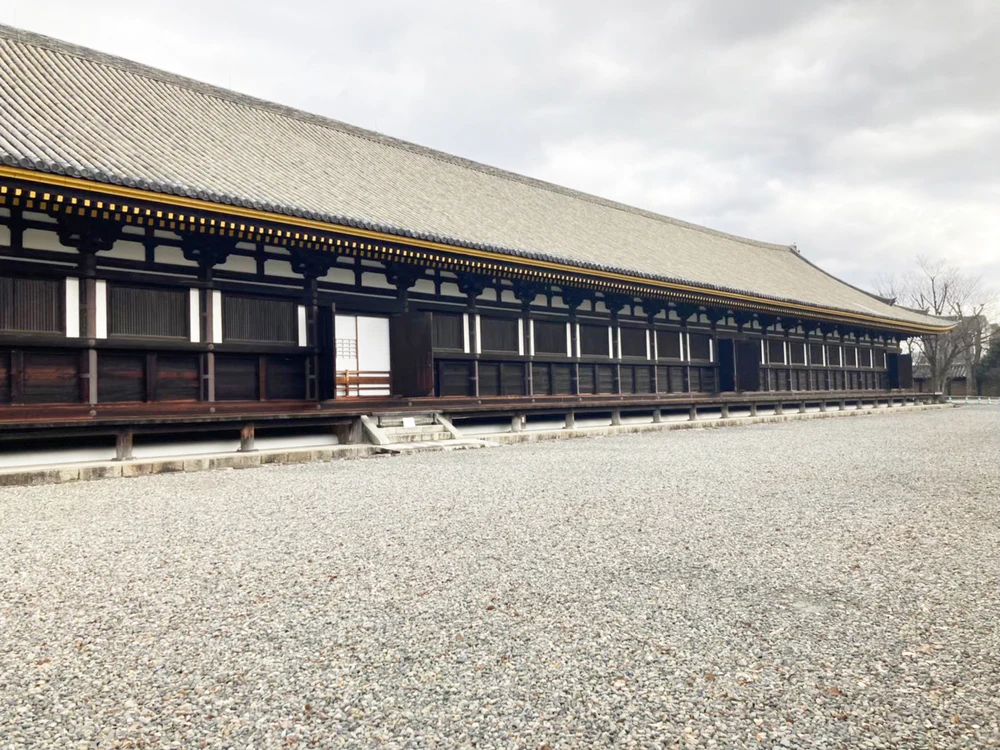
정보
- 개막 시간 : 08:30-17:00 (4/1 - 11/15), 09:00-16:00 (11/16 - 3/31)
- 입장료 : 성인 : 600 엔, 중학교 및 고등학생 : ¥ 400, 초등학생 : ¥ 300
- 주소: 657 Sanjusangendo-Mawari, Higashiyama Ward, Kyoto, 605-0941, 일본
-
교토 역에서 액세스 :
- 버스로 : Kyoto City Bus No. 100, 206 또는 208을 타고 Sanjusangendo-Mae에서 내리십시오 (총 시간 : 약 10 분).
소개 : 평온과 화려 함의 성소

교토의 중심부에 위치한 Sanjusangendo는 풍부한 역사, 심오한 영성 및 복잡한 예술의 매혹적인 조화입니다. 경외심을 불러 일으키는 1001 칸논 조각상으로 유명한이 고대 사원은 방문객들이 시간을 통해 매혹적인 여행을 시작하도록 초대합니다. Sanjusangendo는 1164 년에 설립 된 1164 년에 설립 된 이후 1266 년에 재건축되었습니다. Sanjusangendo는 연례 양궁 대회 인 Toshiya로 유명하며, 이는 달리 고요한 분위기에 역동적이고 흥미로운 터치를 더합니다. 당신이 열렬한 역사가이든, 영적인 구직자이든, 단순히 호기심 많은 여행자이든, Sangusangendo는 일본의 풍부한 문화 태피스트리를 독특하고 통찰력있는 엿볼 수 있습니다. 모든 구석이 과거의 이야기를 속삭이는이 매혹적인 성소를 탐구하는 데 우리와 함께하십시오.
Sangusangendo의 역사
신앙의 기초 : Sangusangendo의 초기
공식적으로 Rengeo-In으로 알려진 Sanjusangendo는 1164 년에 Go-Shirakawa 황제에 의해 설립되었습니다. 성전은 처음에는 더 큰 Hossho-Ji Temple Complex의 일부였으며, 그 자체로는 중요했습니다. 비극적으로, 원래 구조는 파괴적인 불로 손실되었지만 1266 년에 세 심하게 재건되어 원래의 웅장하고 깊은 영적 중요성을 성공적으로 유지했습니다. 길이가 120 미터 인 인상적인 120 미터의 사원의 주요 홀은 일본에서 가장 긴 목조 구조물이라는 구별을 보유하고 있습니다. 이 놀라운 건물은이 지역의 지속적인 건축 및 영적 유산에 대한 증거로 서서 역사적 중요성과 건축의 아름다움에 감탄하는 수많은 방문객들을 끌어 들이고 있습니다.

1001 개의 동상의 수호자 : Sanjusangendo의 심장
Sanjusangendo의 중앙 홀에는 존경받는 자비의 여신 인 1001 명의 실물 크기의 칸논 조각상의 경외심을 불러 일으키는 컬렉션이 있습니다. 12 세기와 13 세기 사이의 절묘한 기술로 제작 된이 조각상들은 세 심하게 행으로 배열되어 있으며, 그들을 보는 모든 사람들에게 강력한 시각적, 영적 영향을 미칩니다. 이 웅장한 디스플레이의 중심에는 카마 쿠라-기간 조각품의 진정한 걸작 인 중앙 무장 칸논 동상이 있으며, 무한한 동정심과 보호를 상징합니다. 1000 명의 상대방으로 둘러싸인이 중심 인물은 자비의 본질을 구현 하고이 역사적인 장소의 특별한 예술성과 영적 깊이를 보여주는 방문객들에게 깊은 초점 역할을합니다.

하찮은 일
나이와 역사적 중요성에도 불구하고 Sangusangendo의 목조 구조는 고대 일본 건축 기술 덕분에 수많은 지진과 화재를 견뎌냈습니다.
양궁의 유산 : Toshiya 전통
성전에서 가장 유명한 행사 중 하나는에도 시대로 거슬러 올라가는 연례 양궁 경쟁 인 Toshiya입니다. 일본 전역의 궁수들이 모여 사원의 120 미터 길이의 홀에서 기술을 보여줍니다. 이 전통은 일본 무술을 선보일뿐만 아니라 사원의 사무라이 문화와의 역사적 연결에 경의를 표합니다.

사진 전망




봄 꽃 : Sanjusangendo의 중생
Sanjusangendo의 봄은 갱신을 축하합니다. 성전 부지에는 벚꽃이 생겨나면서 현지인과 관광객 모두를 끌어들이는 그림 같은 환경을 만듭니다. 고요한 분위기는 하나미 (꽃 관찰)에 적합하며 번잡 한 도시 속에서 고요한 휴양지를 제공합니다.
Summer Splendor : 축제 시간
Summer는 다양한 축제와 문화 행사로 Sanjusangendo에게 활기찬 에너지를 가져옵니다. 성전 주변의 무성한 녹지는 여름 더위에서 시원한 휴식을 제공합니다. 방문객들은 전통적인 일본 공연을 즐기고 지역 축제에 참여하여 활발한 계절이 될 수 있습니다.
가을 우아함 : 색상의 태피스트리
가을은 Sanjusangendo를 빨간색, 주황색 및 금의 캔버스로 변형시킵니다. 성전의 정원과 주변 나무는 가을 단풍의 멋진 전시를 제공합니다. 이번 시즌은 느긋하게 산책과 사진에 이상적이며 자연의 활기찬 팔레트를 배경으로 성전의 아름다움을 포착합니다.
겨울 평온 : 고요한 퇴각
Sanjusangendo의 겨울은 조용한 반사의 시간입니다. 성전의 고요한 분위기는 때때로 강설량으로 향상되어 평화 롭고 명상적인 환경을 만듭니다. 방문객들은 성전의 고요함과 영적 깊이를 경험할 수있어 완벽한 겨울 탈출이 될 수 있습니다.
추천
- 음식 : 유쾌한 요리 경험을 원하시면 Yudofu (두부 Hot Pot) 및 말차 과자를 포함한 전통적인 교토 요리로 유명한 인근 Kiyomizu-Zaka Street를 방문하십시오.
- 경험 : 현지 찻집 중 한 곳에서 다 의도에 참여하는 것을 놓치지 마십시오. 일본의 풍부한 차 문화를 엿볼 수 있습니다.
- 사진 자리 : 성전 1001 칸논 조각상의 아름다움을 포착하지만 홀 내부에서 사진이 제한되어 있다는 것을 기억하십시오. 성전의 외부 정원은 특히 벚꽃과 가을 단풍 시즌 동안 훌륭한 사진 기회를 제공합니다.
교요 야키 도자기 : 교토 세라믹의 예술
Sanjusangendo는 교토의 전통 도자기 지구와 가까운 근접성으로, 교토의 절묘하고 유명한 세라믹 예술 인 교오-야키를 탐험하는 데 관심이있는 사람들에게 이상적인 관문으로 자리 잡고 있습니다. 섬세하고 복잡한 디자인과 활기차고 눈에 띄는 색상으로 축하되는이 기술은 성전의 예술적 유산과 깊고 의미있는 관계를 공유합니다. 이 관계는이 지역의 풍부하고 다양한 문화 역사를 아름답게 반영하고 나타내며, 방문객들은 세대를 통해 전달 된 예술적 전통을 완전히 이해할 수있게합니다.
16 세기로 거슬러 올라가는 Kyo-Yaki 도자기는 도시의 풍부한 예술적 전통을 반영하여 교토의 정교한 미학적 및 세심한 장인 정신을 구현합니다. 교오 예키 도자기의 각 조각은 우아하고 세련된 차 그릇부터 복잡하게 장식되고 아름답게 만들어진 꽃병에 이르기까지 진정한 예술 작품입니다. 현지 도자기 스튜디오와 상점을 방문하면이 지속적이고 놀라운 일본 예술 형식에 대해 더 깊고 몰입하는 인식을 제공하여 Sangusangendo 방문을 완벽하고 풍부하게 보완합니다. 이 경험을 통해이 지역의 예술적 유산에 전적으로 참여하여 교토 탐험에 깊이와 맥락을 더할 수 있습니다.
